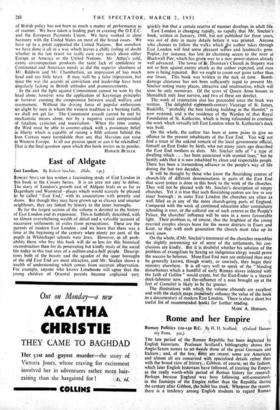East of Aldgate ia st London. By Robert Sinclair. (Hale. m s s.)
°mar SINCLAIR has written a fascinating study of Est London in is book in the County Series. It is an area not easy to define. he story of London's growth east of Aldgate leads us as far as
agenham and Wanstead—places which would scarcely be pleased be called " East End," with its associations with poverty and slums. But though they may have grown up as cleaner and smarter neighbours, they are linked by history to the inner boroughs.
By far the largest section of the volume is devoted to the history of East London and its expansion. This is faithfully described, with an almost overwhelming wealth of detail and a valuable account of successive settlements of exiles from persecutions. These are the parents of modern East London ; and we learn that there was a time at the beginning of the century when ninety per cent. of the pupils in Whitechapel schools were Jews. However, in all prob- ability those who buy this book will do so less for this historical reconstruction than for its penetrating but kindly study of the social life today in this vast area of a million-and-a-half people. Descrip- tions both of the beauty and the squalor of the inner boroughs of the old East End are most attractive, and Mr. Sinclair shows a wealth of understanding which comes from accurate observation. For example, anyone who knows Limehouse will agree that the young children of Oriental parents become anglicised yery quickly but that a certain reserve of manner develops in adult life. East London is changing rapidly, so rapidly that Mr. Sinclair's book, written in January, 1948, but not published for three years,
was out of date in many details before it was printed. Anyone who chootes to follow the walks whichlhe author takes through East London will find some pleasant scrfies and landmarks gone.
Poplar, for instance, has lost its charming access to the river at Blackwall Pier, which has gives way to a new power-station already well advanced. The tower of St. Dunstan's Church in Stepney was not so firm against enemy attack as the author expected, and even now is being repaired. But we ought to count our gains rather than our losses. This book was 'written in the nick of time. Bomb- damage clearance has not been sufficiently rapid to prevent Mr. Sinclair noting many places, attractive and unattractive, which will soon be only memories. Of the score of Queen Anne houses in Shoreditch only four survive, and two of these are derelict.
The work of restoration also has proceeded since the book was written. The delightful eighteenth-century Vicarage of St. James, Radcliffe, " probably the best looking building in the Hamlet," is now restored, and is the residence of the Warden of that Royal Foundation of St. Katharine, which is being refounded to continue the work which virtually left East London when St. Katharine's dock was built.
On the whole, the author has been at some pains to give no offence to the present inhabitants of the East End. You wilj not find a trace of the unkind remark of the local government official, himself an East Ender by birth, who not many years ago described the East End mothers as sluts. Mr. Sinclair tells of " a type of dwelling which . . . has been associated with stunted liyes," but he hastily adds that it is now inhabited by clean and respectable people. There has been a tremendous, advance in the people's way of life during the last two decades.. It will be thought by those who know the flourishing centres of church-life of different denominations in parts of the East End that scant justice is done in this book to the work of the churches.
They will not be pleased with Mr. Sinclair's description of empty churches. Yet it is true that such flourishing centres are few in any inner borough ; in outer East London the churches are often as well filled as in any of the more church-going parts of England. Compared with the work of continued education after compulsory
schooling is over, or the cultural use of such centres as the People's
Palace. the churches' influence will be seen in a more favourable light. Their problem is, of course, that the brightest of the young married couples always leave for the newer districts in Essex and Kent, so that with each generation the church must take up its work anew.
On the whole, if Mr. Sinclair's treatment of the churches resembles the slightly patronising air of some of the settlements, his con-
clusions are kindly. But it, is doubtful whether his solution of the problem of evangelism by having an indigenous clergy would prove the success he believes. More East End men are ordained than may be generally known, though wisely, or unwisely, they begin their ministry elsewhere. It is all -very well to speak of the " blinding disturbances which a handful of early Roman slaves infected with the faith of Galilee " would create, but the EastrEnder is a literate dock-labourer now, and thel.influence of a man brought up at the feet of Gamaliel is likely to be far greater.
The illustrations with which the volume abounds are excellent and with the sketch maps immensely enhance the value of the book as a documentary of modern East London. There is also a short but useful list of recommended books for further reading.
MARK A. HODSON.


































 Previous page
Previous page